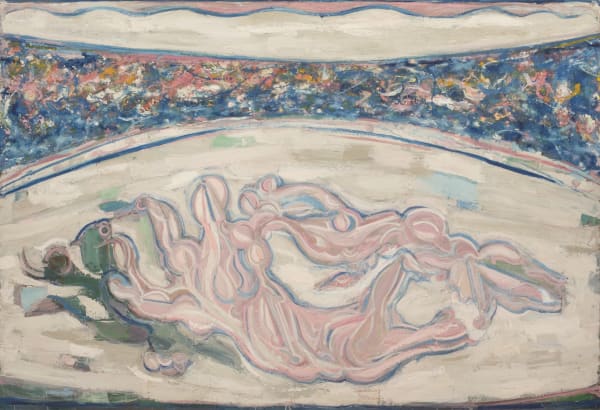Leo Davy: Abstract Scenes: 1973-1987
Born in 1924, Leo Davy (1924-1987) studied painting at Kingston School of Art under Reginald Brill and then at the Slade School of Fine Art whilst the school was evacuated to Oxford during WWII. At the beating heart of post-war abstraction in Britain, as a young man Davy counted Kyffin Williams and John Latham amongst his close friends, and exhibited his paintings alongside William Gear, Victor Pasmore, Prunella Clough, and Alan Davie at a mixed summer show at Gimpel Fils gallery in 1950. Many of these artists were on the cusp of achieving international success and Davy, like Gear and Davie, was situating his work within artistic developments on the continent, particularly CoBrA. A fiercely independent spirit and increasing deafness contributed to Davy’s withdrawal from the mainstream London art world, and his subsequent move to North Devon by the 1960s.
Davy possessed a strong philosophical bent, informing his painting with avid reading and friendships with radical intellectuals including psychiatrist R.D. Laing. The driving urge behind his art, from the 1950s until his death in 1987, was to explore what he termed “non-verbal concepts”, that which existed before language. Aesthetically, this manifested in abstract painting rooted in experience. For Davy, abstraction in paint provided a route for the viewer to reconnect with the innate and the instinctive. From the 1970s until his death in 1987, he channelled the primordial energy of the Cornish landscape - churning waves, broad skies, starry nights, and eeting light e ects - into abstract paintings predominantly in white, blue, and pink, of intense romance. Cornwall became a stage-set, a theatre for performances of pure emotion, expressivity, and elemental forces.
Leo Davy’s disregard for convention meant that, upon his premature death, his work was largely unseen. Following an exhibition at Piano Nobile in 2014 focused on Davy’s works from the 1950s and early 1960s, Leo Davy: Abstract Scenes 1973-1987 primarily presents his later work, with a select grouping of earlier pieces to show his artistic progression. Feminine and enigmatic, Davy’s mature works are luscious scenes of mysterious potency: an ode to the theatrical grandeur of the Cornish environment.
-
 Leo Davy, Head, 1950
Leo Davy, Head, 1950 -
 Leo Davy, Organic Form, 1953
Leo Davy, Organic Form, 1953 -
 Leo Davy, Figures Deconstructed, 1956
Leo Davy, Figures Deconstructed, 1956 -
 Leo Davy, Standing Figures Deconstructed, 1962
Leo Davy, Standing Figures Deconstructed, 1962 -
 Leo Davy, Horizon II, 1981
Leo Davy, Horizon II, 1981 -
 Leo Davy, Large Horizon, 1982
Leo Davy, Large Horizon, 1982 -
 Leo Davy, The Bridge, 1982
Leo Davy, The Bridge, 1982 -
 Leo Davy, Scene II, 1982
Leo Davy, Scene II, 1982 -
 Leo Davy, Untitled , 1984 c.
Leo Davy, Untitled , 1984 c. -
 Leo Davy, White Painting II, 1986
Leo Davy, White Painting II, 1986











